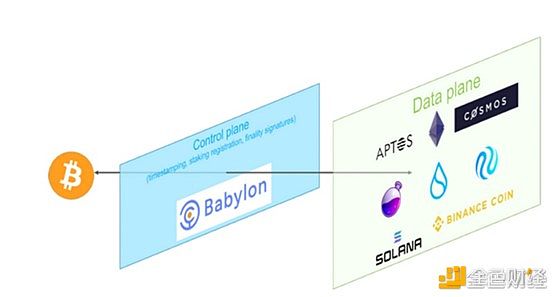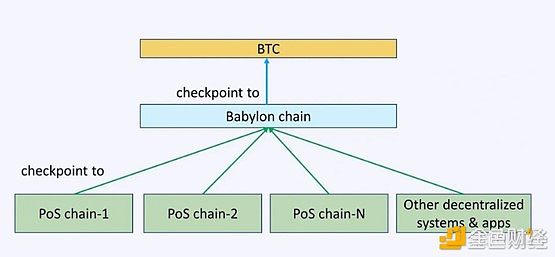Babylon launches BTCFi track again

Reprinted from jinse
04/28/2025·14DAuthor: Revc, Golden Finance
The Babylon platform announced that its Bitcoin staking main network has officially launched. In the first stage, the platform set a stake limit of 1,000 Bitcoins, and all of this limits have been reached. According to platform data, more than 12,700 users have participated in the pledge, with a total pledge value exceeding 1,000 Bitcoins.
What is Babylon
Babylon is a protocol designed to leverage the security of Bitcoin to provide security for other PoS chains. Babylon can provide secure, cross-chain-free, host-free native staking solutions for PoS chains including BTC layer2, and promote cross-chain interoperability. It is usually analogized as the Eigenlayer of the Ethereum ecosystem.
The core principle of Babylon
-
Remote staking: Use Bitcoin's UTXO model and scripting system to realize staking, confiscation and rewards for Bitcoin.
-
Timestamp Server: Provides an untamperable timestamp to these events by recording events of PoS chains on the Bitcoin blockchain.
-
Three-layer architecture: Bitcoin is the bottom layer, Babylon is the middle layer, and PoS chain is the upper layer. Babylon is responsible for recording the checkpoints of the PoS chain to Bitcoin.

Advantages of Babylon
-
Enhance PoS chain security: Use Bitcoin’s security to improve the attack resistance of PoS chains.
-
Shorten the pledge cycle: Shorten the pledge cycle of the PoS chain through the timestamp mechanism of Bitcoin.
-
Promote cross-chain interoperability: Enable seamless communication and data sharing between different blockchains.
-
Bring new vitality to the Bitcoin ecosystem: Activate dormant Bitcoin and bring new application scenarios to the Bitcoin ecosystem.
BTCFi Ecology Overview
At present, the Bitcoin ecosystem has entered the stage of large-scale infrastructure, and all parties are rushing to enter the BTCFi track. After all, the track has assets worth nearly US$1.5 trillion to be activated. Here is a list of top BTCFi projects:
BounceBit
BounceBit combines CeFi and DeFi to provide Bitcoin with a more flexible way to make returns. Through liquidity custody and restaking, users can earn profits on multiple chains.
Core functions:
-
CeFi+DeFi combination: deposit Bitcoin into the CeFi platform and participate in the DeFi protocol to obtain dual benefits.
-
Liquidity custody: Provides liquid custody services so that users can redeem assets at any time.
-
Re-pled: Allow users to pledge the pledged Bitcoins to other protocols again to obtain more profits.
-
Technical design: BounceBit ensures the security of cross-chain assets through validator consensus, Mainnet Digital's hosting services, and Ceffu's MirrorX technology multiple security mechanisms, reducing the risk of hacker attacks.
Solv Protocol
Solv Protocol creates a full-chain earnings Bitcoin asset SolvBTC, which introduces Bitcoin liquidity into various DeFi protocols.
Core functions:
-
SolvBTC: A derivative asset representing staking Bitcoin, which can be used on multiple chains.
-
Decentralized asset management: Ensure assets security through smart contracts and multiple signatures.
-
Cross-chain interoperability: Supports the use of SolvBTC on multiple blockchains.
-
Technical design: Concentrate various liquidity resources and investment opportunities on one platform, and users can achieve automated investment by setting up trading strategy Vault.
Yala
Yala aims to build a multi-chain stablecoin ecosystem that leverages the liquidity of Bitcoin.
Core functions:
-
Multi-chain stablecoins: Provides stablecoins based on Bitcoin that can be used on multiple chains.
-
DeFi ecosystem: Provides DeFi services such as lending and pledge.
-
Modular architecture: Flexible and scalable, supporting custom modules.
At present, the parties have adopted a centralized approach in security solutions, namely CeFi and multi-signature, trying to maximize the activation of value flow on the Bitcoin chain, because although on-chain verification methods such as UTXO are used to ensure security through decentralization, it is difficult to stimulate value flow due to the lack of a complete smart contract system on Bitcoin, and on-chain verification is mostly used in the re-stake track.
Thoughts on Bitcoin Re-staked Track
Going back to the re-staking track where Babylon is located, first of all, blockchain mainly shares security consensus through modular means. Modular blockchain provides infrastructure for other blockchains by "leasing" the security, decentralized characteristics and value consensus of high-quality public chains such as Bitcoin and Ethereum, thereby improving the performance and efficiency of blockchains. Currently, it is mainly divided into three categories:
Ethereum-based solution:
-
Advantages: High security and strong legality, and can directly utilize Ethereum ecological resources.
-
Disadvantages: Throughput and cost may be low and are not suitable for all types of application chains.
Brand new DA layer solution (such as Celestia):
-
Advantages: Good performance and low cost, aiming to provide security and decentralized features comparable to Ethereum.
-
Disadvantages: Security and decentralized features still require time verification, lack of legitimacy, and may be excluded by the Ethereum community.
Proof of Stake (POS) shared security solutions (such as Babylon, EigenLayer):
-
Advantages: Inheriting the legitimacy and security of Bitcoin or Ethereum, providing more practical value for its assets and high flexibility.
-
Disadvantages: Relatively new, long-term performance still needs to be observed.
Babylon adopts the core concept of Proof of Stake ( POS ) that uses the asset value of Bitcoin or Ethereum to create shared security services. The advantage is that it also provides more practical value for main chain assets while inheriting legitimacy and security. But it also triggered a series of thoughts:
In the Ethereum network, the security responsibility of general stakeholders is greater than that of non-stakeholders, because the ETH in the stake participates in consensus maintenance, while the ETH in circulation is actually the beneficiary of network security, and they also pay the opportunity cost of stake. Therefore, from the perspective of sharing security, the proof of stake sharing solution is currently lower than the basic solution of Ethereum, unless the assets of the proof of stake solution are stETH and other assets, because stETH corresponds to the ETH participating in verification in the Ethereum network. It is roughly understood that the Ethereum network is secure, and other PoS networks that use stETH stake are also secure.
The security sharing logic of Babylon's PoW+PoS solution is not perfect enough. First of all, the main personnel of the security maintenance system of the Bitcoin network are miners. Although miners are also driven by the interests of the BTC token value itself, the Bitcoin holders pledged in the Babylon protocol did not directly and actively maintain the security of the Bitcoin network, and did not directly transmit the security of the Bitcoin network to the Pos network of China Unicom's Babylon network. Here we can think about whether the safe beneficiaries can also pass on security protection to others. In other words, the security of the entire PoS network is related to the low Bitcoin network and strong Bitcoin stakeholders. Therefore, we need to think about whether sharing security is sharing at the asset level (more like a guarantee) or sharing at the network level.
BTC stakers or holders do not actively maintain the security of Bitcoin and PoS networks. Judging from the first phase of Babylon, the Bitcoin network is more like passively receiving data from the PoS network. In fact, the overall security depends more on Babylon's PoS network itself.

From a quantitative perspective, the 1,000 Bitcoins in the first stage account for a very small share of Bitcoin's current circulation. Economically, the current PoS chain does not have the security of the shared Bitcoin network. The security of shared assets and the security of the network where the shared assets are located are two concepts, which is worth further discussion.
In addition, technically, how does the timestamp of PoS coordinate with the timestamp of the Bitcoin network block? The block generation time of the Bitcoin network is in minute order, and there is certain uncertainty in the block generation time and transaction confirmation. The finality of the PoS network confirmation transaction is in seconds, which immediately creates a block synergy problem between PoS and PoW.
summary
The Bitcoin network is the most valuable decentralized network. Many BTCFi track projects including Babylon have the potential to make the Bitcoin network the cornerstone of the entire crypto industry and bring new possibilities to the Bitcoin ecosystem.
In the process of development, in addition to focusing on the inheritance of decentralized attributes, because the BTCFi project involves a huge amount of funds, it is also necessary to attach great importance to the security of protocols and smart contracts.




